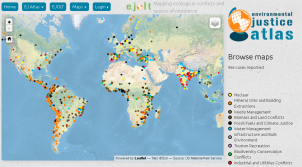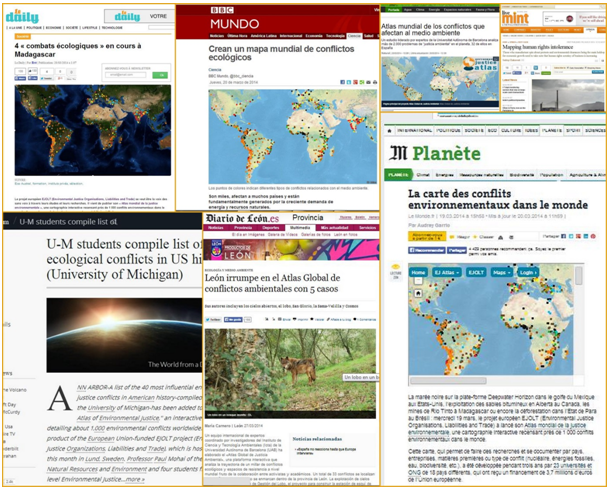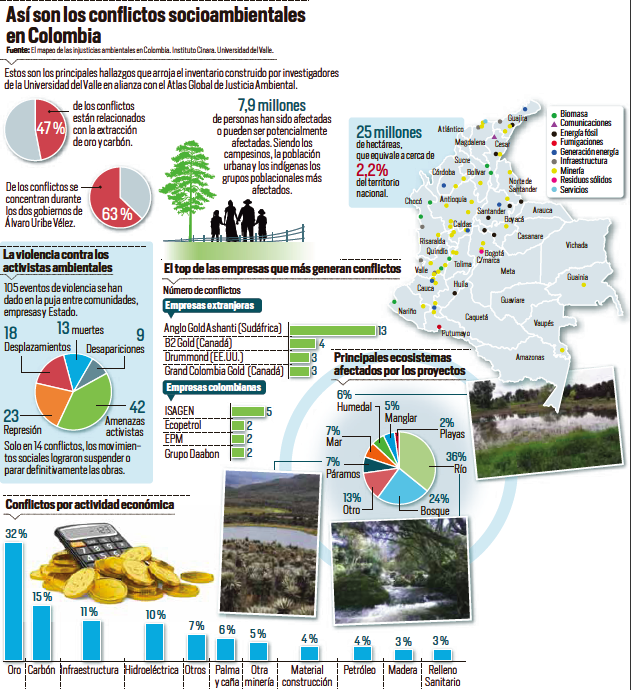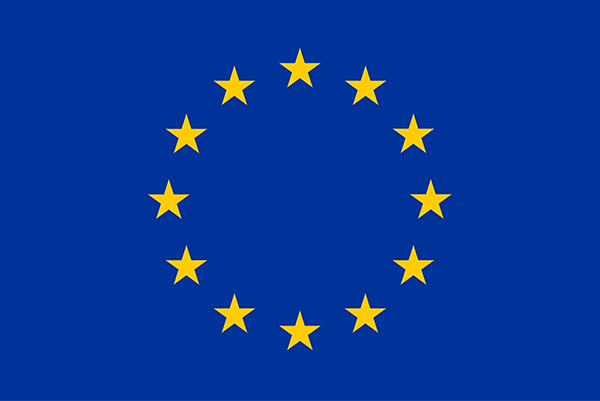
By Leah Temper.
The Atlas of Environmental Justice has been making waves across the world. Since the launch we have had over 130 press mentions in 21 countries and more than 100,000 visitors to the site. Below is a round-up of some notable press mentions
From India, the Live Mint of the Wall Street Journal noted that the Atlas shows how human rights scrutiny of business is increasing. “The Indian and global lists are far from comprehensive, but the information is scalable and can quickly incorporate data and critical perspectives. It’s a list that cannot be wished away by the government’s blocking of such websites, or accusations that it’s a conspiracy of Maoist rebels, of “pseudo-intellectuals” or “pseudo-secularists”…. Unless India adopts the don’t-give-a-damn approach of China, in the game of public relations truth-or-dare there is nowhere for India to cut and run. The increasing globalization of social networking, activism and accountability makes it so….. Those who manufacture spin about protests and environmental clearances being the main hold-up for businesses and economic growth in India, not massive and deliberate administrative ineptitude, impractical policies, populist fiscal payouts and rivers of corruption that flow as quick in dry summer months as they do at monsoonal spate, would need to take note. Human rights scrutiny of business is increasing. Deal with it.”
According to another article in the Hindustan Times: Snehal Rebello writes how most of the projects (in India) have come up after 1991’s economic liberalisation. “A majority of people in India, unlike in developed and middle-income countries, depend on natural resources such as forest, land and water. In the name of so-called development, the government first lays its hands on these resources and those directly affected are the weakest,” said Himanshu Thakkar of Delhibased South Asia Network of Dams, Rivers and People. India has witnessed several protests in different parts with locals opposing projects with environment conflicts. “The regard for environment laws, forest rights, social justice have deteriorated rapidly and all projects are being sanctioned,” said ecologist Madhav Gadgil…“As a result, people are getting desperate because the government is flouting both people’s rights and environment rules.”
From Spain, a newspaper in Leon (that has 5 conflicts out of the 36 reported) noted that Spain doesn’t react to its environmental conflicts, that include megaprojects such as the private San Glorio Ski Complex to the public Ciudad Real Airport, until Europe intervenes, writing: “Los expertos destacan que el sistema político español es «extremadamente lento» a la hora de reaccionar a un movimiento ambiental, y es generalmente Europa la que tiene que mediar en los conflictos, como ocurrió con los cielos abiertos de Laciana.”
From France, we were covered in the Le Monde daily. While they note that France only has 6 cases, they included our call out for collaboration, noting that the current cases are neither exhaustive nor include all the emblematic ones that the Atlas calls on groups to collaborate to reach 2000 cases by next year.
In Belgium, Leah Temper was interviewed for the Quarterly MO magazine under the title “Western Consumption: A source of environmental conflicts”. The journalist writes that the conflicts are not accidental incidents but common practices of the current economic model and asks “What instruments do local communities have to defend themselves? How can companies be made more accountable? Or even better, how can we slow down the pressure on these commodities crazes? The article highlights the importance of access to justice and civil liability for companies as regards such conflicts, but also recommends criminal liability and laws against ecocide. The interview concludes by noting that it is ultimately about the question of how fair distribution, participation and the transformation of production models.
Science Magazine covered the map, noting that of the 915 conflicts listed at the time 271 involve local scientists and professionals, and 17% are described as environmental victories.
Along with international coverage from the BBC, countries such as Uruguay, Panama, Argentina, Madagascar, Bulgaria, Italy, etc….carried headlines, often clamouring to proclaim their place and prominence on the map.
Perhaps our best coverage has been from Colombia where top newspapers such as El Tiempo see graphic below – they win the prize for best infographics), La Semana and El Espectador have carried pages full of information on the EJOLT Atlas, compiled by Dr. Mario A. Perez and his collaborators at CINARA and Universidad del Valle, Cali. The launch also coincided with a terrible drought in the country that brought to the fore problems of oil extraction, featured on the cover of La Semana with the title “Environmental Nightmare”.
In a new article in El Espectador, Carlos Andrés Baquero shows the incidence of environmental conflicts in areas inhabited by indigenous and Afro- colombian minorities. Using data from the EJOLT map, he shows that of the 72 cases already uploaded a few weeks ago, in 42 there is involvement of such ethnic minorities, a proportion much higher than in the population as a whole. Indigenous communities are hit twice as much as Afrocolombian communities.







This is a great site. I will use it in my classes!